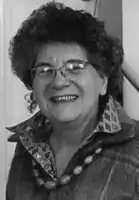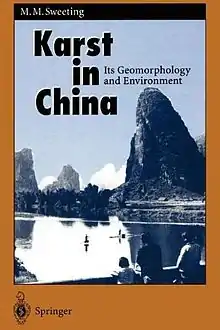Marjorie Sweeting
Marjorie Mary Sweeting (28 February 1920 – 31 December 1994 in Oxford), was a British geomorphologist specializing in karst phenomena. Sweeting had gained extensive knowledge on various typographies by travelling to places such as Greece, Australia, Czechoslovakia, United States, Canada, South Africa, Belize, and most notably China. She published Karst Landforms (Macmillan 1972), and Karst in China: its Geomorphology and Environment (Springer 1995) after many years of work there starting in 1977; the latter is the first comprehensive Western account of China's karst.[1][2] She created one of the first western published works on the karst found within China, even in a male dominated field.[3]
Marjorie Sweeting | |
|---|---|
 | |
| Born | 28 February 1920 Fulham, London |
| Died | 31 December 1994 Oxford |
| Resting place | London's Euston church |
| Scientific career | |
| Fields | Geomorphologist |
Early life
Marjorie May Sweeting was born to George Scotland Sweeting and his wife Ellen Louisa Liddiard in Fulham in 1920. She was an only child, and her father, G.S. Sweeting, was a geology lecturer at the Imperial College, in London.
Education
Her secondary education took place in Mayfield School and later graduated in 1981 from Newham College, Cambridge. She was accepted as a Caroline Turle Research Fellow at Newnham College, Cambridge during 1942 for a year, later returning in 1945 for the Marion Kennedy Research.[4]
Career
In 1987 Marjorie Sweeting retired from her position as Reader in Geography at The University of Oxford. She was also a Fellow and Tutor at St Hugh's College 1951–87 (Emeritus), and Lecturer and Reader at Oxford University 1954–87. During 1948, Sweeting became a PhD candidate who wrote her thesis based on The Landforms of the Carboniferous Limestone of Ingleborough District, N.W. Yorkshire.[4] In 1951 Marjorie Sweeting was appointed Lecturer and Director of studies in Geography at St. Hugh's College, 1983 she was named the Acting head of the school.[5] Sweeting served on the Karst Commission of the International Geographical Union, where she came to work on a new project titled, Man's Impact on the Karst. Additionally, Sweeting worked with Gordon Warwick in support of the International Speleological Union where she was in charge of the Karst Denudation. Another one of Marjorie's accomplishments in her career was being a leader on an exhibition called the “Expedition to Gunung Mulu” from 1977 to 1978. She was the program director for the Landform and Hydrology Survey for the Royal Geographical Society.[6] The exhibition was held to observe speeds of erosion and how quickly land was being formed in a forest of equatorial conditions.[7]
A major feature of Marjorie Sweeting’s career was her influence on generations of undergraduates and graduates. Many were the Saturdays and vacation weeks she organized field trips for undergraduates, introducing them to caves and the pleasures of karstic landscapes.[5]
Achievements
Sweeting contributed largely to the field of karst. Her many awards included those of Gill Memorial Prize of the Royal Geographical Society (1955), Certificate of Merit of the National Speleological Society of America (1959), Honorary Member of the Cave Research Foundation of America (1969),[4] and the Busk medal (1980).[8]
Due to her important and ground-breaking work in the field of geomorphology, The British Society for Geomorphology created "The Marjorie Sweeting Award" in 2008. [9] The award goes to be the best undergraduate dissertation in the field of geomorphology at any university in the UK. The prize is £200.
Later life
Upon her retirement in 1987, Sweeting continued her research on karst whilst in China, which resulted in her final academic work, “Karst in China: its Geomorphology and Environment,” which was published posthumously, in 1995. Even after her retirement, she remained highly passionate about the work she did and continued advocating for studies and research done on the topic. [10]
Other
Marjorie Sweeting was a keen potholer and one way in which she introduced students to karst was to take them caving. Unable to continue her studies during World War II she went to Denbigh, North Wales as a geography teacher at Howells School.
From 1977, when she led the initial expedition, Sweeting worked extensively on the karst landforms of China.

There was plenty of scope – karst covers about one-seventh of the country, over five hundred thousand square kilometers. This was the first study of the karst regions of China by a western geomorphologist.[4]
Marjorie was acknowledged not only as an international expert on karst geomorphology but also as a generous and enthusiastic mentor for generations of undergraduate and graduate students.
For much of her career, Marjorie was one of only a small group of female physical geographers in Britain who fought hard and successfully to establish their international scientific reputation.
After retirement, Marjorie Sweeting continued her research in China which culminated in ‘Karst in China: its Geomorphology and Environment’, the manuscript being published in 1995, shortly after her death. It is the first comprehensive Western account of China's karst.[1][2] A special issue of ‘Zeitschrift für Geomorphologie’ on ‘Tropical and subtropical karst’ was published in her honour in 1997. Marjorie had written over seventy different publications in her life [11] and she was probably the best-known and most influential woman geomorphologist of her time [5]
See also
References
- Kennedy, Barbara (18 January 1995). "OBITUARIES: Marjorie Sweeting". The Independent.
- Karst in China - Its Geomorphology and Environment | Marjorie M. Sweeting. Springer Series in Physical Environment. Springer. 1995. ISBN 9783642795220. Retrieved 8 August 2018.
- Goudie, Andrew (July 1995). "Obituaries: Marjorie Sweeting 1920-1994". Geographical Journal. 161 (2): 239–240.
- Gouldie, Andrew; Ford, Derek; Sugden, David (28 October 2016). "Dr. Marjorie Sweeting". Earth Surface Processes and Landforms. 12 (5): 445–451. doi:10.1002/esp.3290120502.
- Goudie, A.S. (July 1995). "Obituaries: Marjorie Sweeting 1920-1994". The Geographical Journal. 161 (2): 239–240. JSTOR 3060006.
- "Marjorie Sweeting". oxfordgeoscience. Retrieved 7 February 2021.
- Sweeting, Marjorie (1980). "The Geomorphology of Mulu: An Introduction". The Geographical Journal. 146 (1): 1–7. doi:10.2307/634064. JSTOR 634064.
- Viles, H.A. (1996). "Obituary: Marjorie Sweeting 1920-1994". Transactions of the Institute of British Geographers. 21: 429–432.
- "The Marjorie Sweeting Award | British Society for Geomorphology". www.geomorphology.org.uk. Retrieved 7 February 2021.
- Hunter, Dana. "Marjorie Sweeting: "The Basis for a World Model of Karst"". Scientific American Blog Network. Retrieved 7 February 2021.
- Sweeting, Marjorie (1973). Karst Landforms. London: Columbia University Press. p. 362.